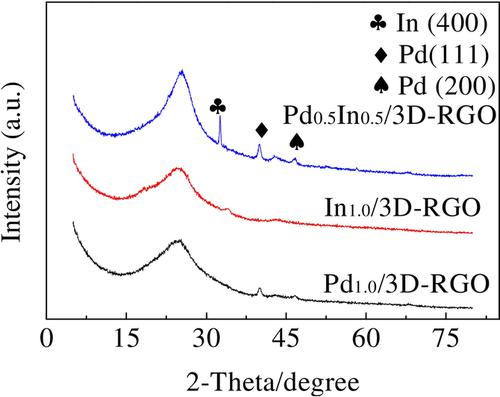当前位置:
X-MOL 学术
›
Electroanalysis
›
论文详情
Our official English website, www.x-mol.net, welcomes your
feedback! (Note: you will need to create a separate account there.)
Highly Selective and Active Pd-In/three-dimensional Graphene with Special Structure for Electroreduction CO2 to Formate
Electroanalysis ( IF 2.7 ) Pub Date : 2017-11-07 , DOI: 10.1002/elan.201700525 Guangya He 1 , Hanyu Tang 1 , Hui Wang 1 , Zhaoyong Bian 2
Electroanalysis ( IF 2.7 ) Pub Date : 2017-11-07 , DOI: 10.1002/elan.201700525 Guangya He 1 , Hanyu Tang 1 , Hui Wang 1 , Zhaoyong Bian 2
Affiliation

|
Electrocatalytic reduction of CO2 to formate on carbon based electrodes is known to suffer from low electrochemical reaction activity and product selectivity. Pd/three-dimensional graphene (Pd/3D-RGO), In/3D-RGO and Pd-In/3D-RGO for the electrochemical reduction of CO2 were prepared by a mild method that combines chemical and hydrothermal. The metal/3D-graphenes (metal/3D-RGO) were characterized by scanning electron microscopy, X-ray diffraction, transmission electron microscopy and X-ray photoelectron spectroscopy (XPS). Cyclic voltammetry and the ion chromatography were performed to investigate the electrochemical performance of the metal/3D-RGO. The morphology and dispersion of metal/3D-RGO are 3D structure with amount of interconnected pores with metal NPs loading on the fold. And the Pd0.5-In0.5/3D-RGO show excellent surface performance with well dispersion and smallest particle size (12.8 nm). XPS reveal that binding energy of Pd (In) NPs is shifted to negative energy, for the metal lose electrons in metal and combine with C, which is demonstrated in the HNO3 experiment. The peak potential of Pd0.5-In0.5/3D-RGO is −0.70 V (vs. Ag/AgCl), which is more positive than In1.0/3D-RGO (−0.73 V) and Pd1.0/3D-RGO (−1.2 V). The highest faradaic efficiency (85.3 %) happens in Pd0.5-In0.5/3D-RGO at −1.6 V vs. Ag/AgCl. In these experiments, the special structure that metal NPs combine with C and the bimetal NPs give a direction to convert CO2 to formate.
中文翻译:

具有特殊结构的高选择性和活性 Pd-In/三维石墨烯用于电还原 CO2 形成甲酸盐
已知在碳基电极上将 CO2 电催化还原为甲酸盐的电化学反应活性和产物选择性较低。通过结合化学和水热的温和方法制备了用于电化学还原 CO2 的 Pd/三维石墨烯 (Pd/3D-RGO)、In/3D-RGO 和 Pd-In/3D-RGO。金属/3D-石墨烯(金属/3D-RGO)通过扫描电子显微镜、X射线衍射、透射电子显微镜和X射线光电子能谱(XPS)进行表征。进行循环伏安法和离子色谱法以研究金属/3D-RGO 的电化学性能。金属/3D-RGO 的形态和分散是 3D 结构,具有大量相互连接的孔,折叠上负载有金属 NP。和 Pd0.5-In0。5/3D-RGO 表现出优异的表面性能,具有良好的分散性和最小的粒径 (12.8 nm)。XPS 揭示 Pd (In) NPs 的结合能转移到负能量,因为金属在金属中失去电子并与 C 结合,这在 HNO3 实验中得到了证明。Pd0.5-In0.5/3D-RGO 的峰值电位为 -0.70 V(相对于 Ag/AgCl),比 In1.0/3D-RGO (-0.73 V) 和 Pd1.0/3D 更正-RGO (-1.2 V)。最高法拉第效率 (85.3 %) 发生在 -1.6 V 与 Ag/AgCl 的 Pd0.5-In0.5/3D-RGO 中。在这些实验中,金属 NPs 与 C 结合的特殊结构和双金属 NPs 为将 CO2 转化为甲酸盐提供了方向。这在 HNO3 实验中得到了证明。Pd0.5-In0.5/3D-RGO 的峰值电位为 -0.70 V(相对于 Ag/AgCl),比 In1.0/3D-RGO (-0.73 V) 和 Pd1.0/3D 更正-RGO (-1.2 V)。最高法拉第效率 (85.3 %) 发生在 -1.6 V 与 Ag/AgCl 的 Pd0.5-In0.5/3D-RGO 中。在这些实验中,金属 NPs 与 C 结合的特殊结构和双金属 NPs 为将 CO2 转化为甲酸盐提供了方向。这在 HNO3 实验中得到了证明。Pd0.5-In0.5/3D-RGO 的峰值电位为 -0.70 V(相对于 Ag/AgCl),比 In1.0/3D-RGO (-0.73 V) 和 Pd1.0/3D 更正-RGO (-1.2 V)。最高法拉第效率 (85.3 %) 发生在 -1.6 V 与 Ag/AgCl 的 Pd0.5-In0.5/3D-RGO 中。在这些实验中,金属 NPs 与 C 结合的特殊结构和双金属 NPs 为将 CO2 转化为甲酸盐提供了方向。
更新日期:2017-11-07
中文翻译:

具有特殊结构的高选择性和活性 Pd-In/三维石墨烯用于电还原 CO2 形成甲酸盐
已知在碳基电极上将 CO2 电催化还原为甲酸盐的电化学反应活性和产物选择性较低。通过结合化学和水热的温和方法制备了用于电化学还原 CO2 的 Pd/三维石墨烯 (Pd/3D-RGO)、In/3D-RGO 和 Pd-In/3D-RGO。金属/3D-石墨烯(金属/3D-RGO)通过扫描电子显微镜、X射线衍射、透射电子显微镜和X射线光电子能谱(XPS)进行表征。进行循环伏安法和离子色谱法以研究金属/3D-RGO 的电化学性能。金属/3D-RGO 的形态和分散是 3D 结构,具有大量相互连接的孔,折叠上负载有金属 NP。和 Pd0.5-In0。5/3D-RGO 表现出优异的表面性能,具有良好的分散性和最小的粒径 (12.8 nm)。XPS 揭示 Pd (In) NPs 的结合能转移到负能量,因为金属在金属中失去电子并与 C 结合,这在 HNO3 实验中得到了证明。Pd0.5-In0.5/3D-RGO 的峰值电位为 -0.70 V(相对于 Ag/AgCl),比 In1.0/3D-RGO (-0.73 V) 和 Pd1.0/3D 更正-RGO (-1.2 V)。最高法拉第效率 (85.3 %) 发生在 -1.6 V 与 Ag/AgCl 的 Pd0.5-In0.5/3D-RGO 中。在这些实验中,金属 NPs 与 C 结合的特殊结构和双金属 NPs 为将 CO2 转化为甲酸盐提供了方向。这在 HNO3 实验中得到了证明。Pd0.5-In0.5/3D-RGO 的峰值电位为 -0.70 V(相对于 Ag/AgCl),比 In1.0/3D-RGO (-0.73 V) 和 Pd1.0/3D 更正-RGO (-1.2 V)。最高法拉第效率 (85.3 %) 发生在 -1.6 V 与 Ag/AgCl 的 Pd0.5-In0.5/3D-RGO 中。在这些实验中,金属 NPs 与 C 结合的特殊结构和双金属 NPs 为将 CO2 转化为甲酸盐提供了方向。这在 HNO3 实验中得到了证明。Pd0.5-In0.5/3D-RGO 的峰值电位为 -0.70 V(相对于 Ag/AgCl),比 In1.0/3D-RGO (-0.73 V) 和 Pd1.0/3D 更正-RGO (-1.2 V)。最高法拉第效率 (85.3 %) 发生在 -1.6 V 与 Ag/AgCl 的 Pd0.5-In0.5/3D-RGO 中。在这些实验中,金属 NPs 与 C 结合的特殊结构和双金属 NPs 为将 CO2 转化为甲酸盐提供了方向。









































 京公网安备 11010802027423号
京公网安备 11010802027423号